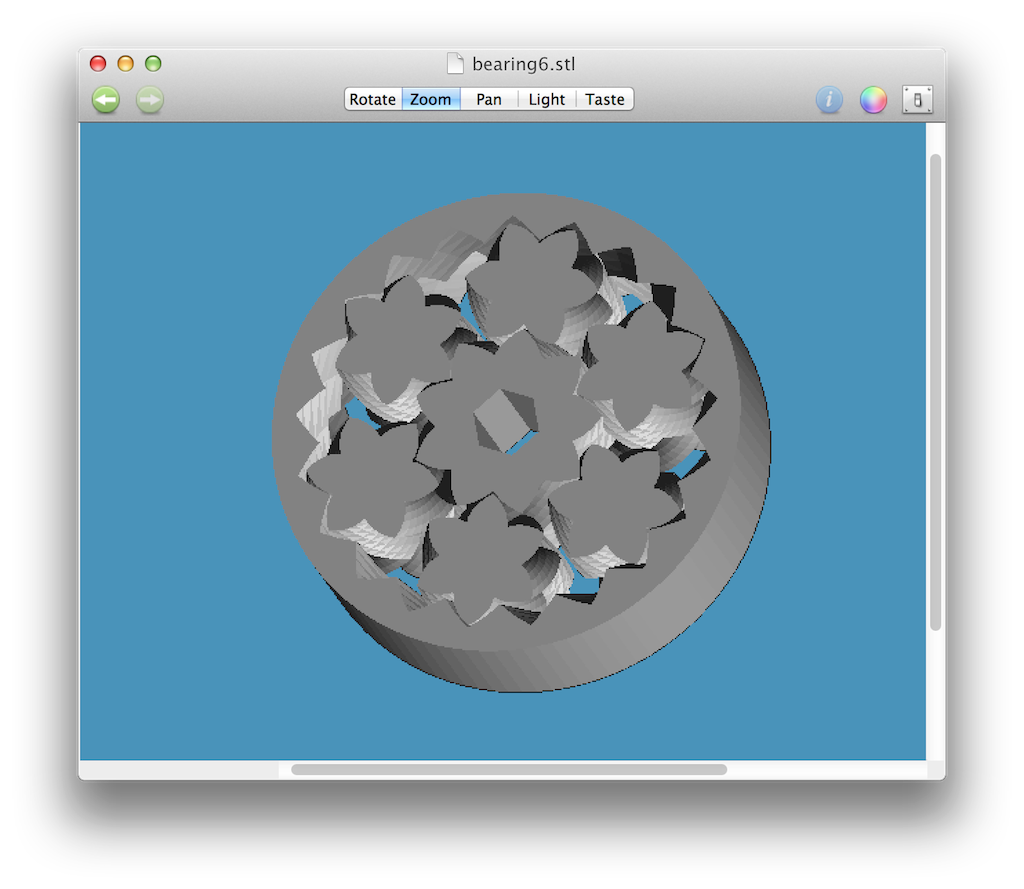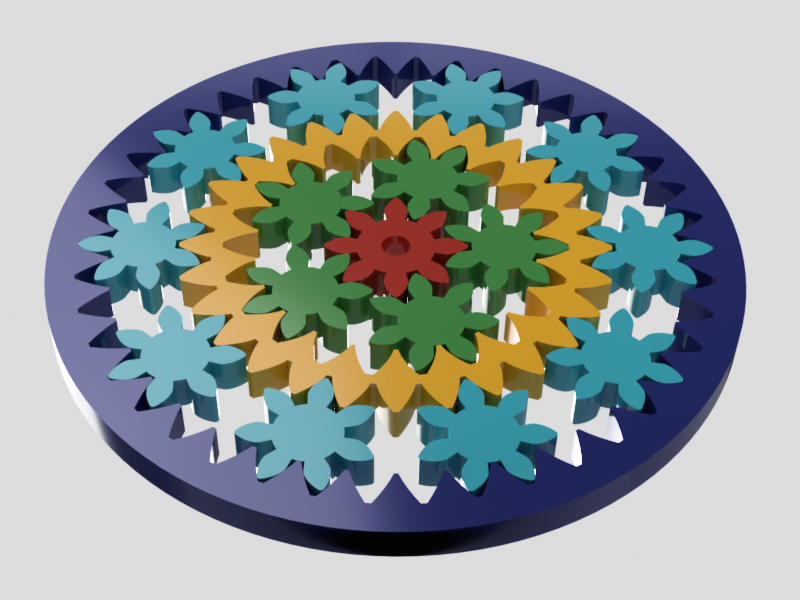If you’ve seen my websites (here and here) you’ll know that I love mechanical gadgetry. Sometimes the mere mention of a particular mechanism or mechanical problem awakens this obsession, for which there’s no cure but to work out a solution.
Such was the case a few nights back, when a number of us happened to be in the 3D printing/Laser cutter room working on a variety of unrelated projects. In the midst of it all, Cere and I struck up a conversation about an interesting planetary gear mechanism she found on Thingiverse. Here it is:
 http://www.thingiverse.com/thing:53451
http://www.thingiverse.com/thing:53451
The designer, Emmett Lalish, is an expert in the nuances of 3D printed design and a prolific contributor to Thingiverse. His projects are very popular and highly recommended.
This mechanism illustrates captured planetary gears that require no carrier. The gears have a herringbone tooth form and are printed in-place, so they require no assembly and cannot be disassembled. The mechanism is an entertaining illustration of the potential of 3D printing, and has practical application as a roller or thrust bearing.
Cere was thinking that it might be an appropriate driver for a kinetic sculpture idea she’s toying with. In her application the ring would be stationary, the sun gear motorized, and the planet gears would drive the sculpture. I hope we can persuade her to blog about the sculpture portion, which sounds fascinating. I must confess that I was more interested in the driving mechanism.
Cere’s idea was to expand Emmett’s design by adding teeth to the outer perimeter of the ring, another set of planet gears and another ring, all driven by the central sun gear. I knew at the time that there would be an additional degree of freedom in that mechanism that would cause trouble, but with everything going on that night I couldn’t clearly articulate my thoughts. Anyway, it’s much easier with illustrations, and was a good exercise to get more proficient with Fusion 360’s assembly and rendering tools.
Here’s my copy of the original mechanism. I’m using simple spur gears for clarity.
And here’s the extension Cere envisioned. The ring becomes a sun gear in a larger version of the same mechanism.

The problem here is that the mechanism is not deterministic. The inner ring floats without being positively driven.
For example, the inner ring (yellow in this model) might, due to friction, remain stationary and not drive the outer planets at all, as illustrated here:
Then again, there might be such friction in the inner assembly to make it revolve as a unit, driving the outer planets as expected but without properly turning the inner planets about their axes, as illustrated here:
In practice the result would probably be a inconsistent mixture of the two, with erratic motion in fits and starts. What we want is a mechanism that smoothly revolves all the planets about their axes while they orbit the sun gear. Here’s what I think Cere really wants:
From this we can see that the inner ring must somehow be made to turn at a particular ratio with respect to the rest of the mechanism. I’m sure there are many ways to do this, but the most appealing to me is to create another sun-and-planet mechanism beneath this one! The carrier of this driving layer is fastened to the inner ring gear of the main mechanism. The upper mechanism then behaves as desired.
Of course, there are simpler mechanisms that might meet Cere’s needs. Perhaps the easiest modification is to just enlarge the sun gear so we could accommodate more planets.
Here’s a gear train that contains a series of planet gears in a sort of pinwheel arrangement between the sun and ring. We will need a carrier in this case, and some of the planets revolve in the opposite direction, but we don’t need a two-stage device.
It’s been fun exploring the options. If you’d like to know more, here’s a good explanation of planetary gear ratios and how to calculate them:
http://woodgears.ca/gear/planetary.html
To model the gears, I have a Fusion 360 add-in installed. I can’t remember whether Fusion came with it or I installed it later… In any case, I modified it to suit my needs, which might be a good blog post in its own right.
I hope this has inspired you to come up with your own mechanisms! Please blog about it if you do.


So awesome, Matt! Thanks for this post. I can’t be the only one with such weird thoughts and questions about gears.
Did you ever made the video on how to model and animate the gears? or the name of the add-in? I found you lesson really interesting thanks
thanks